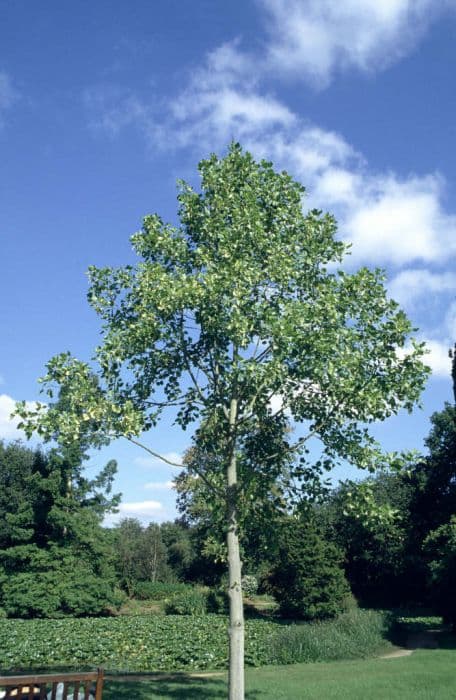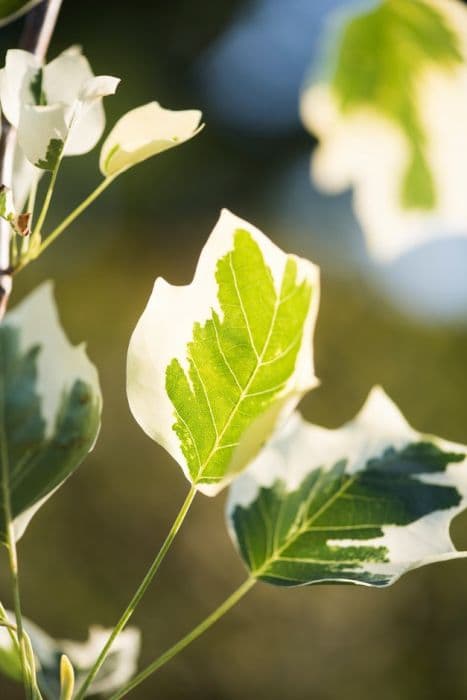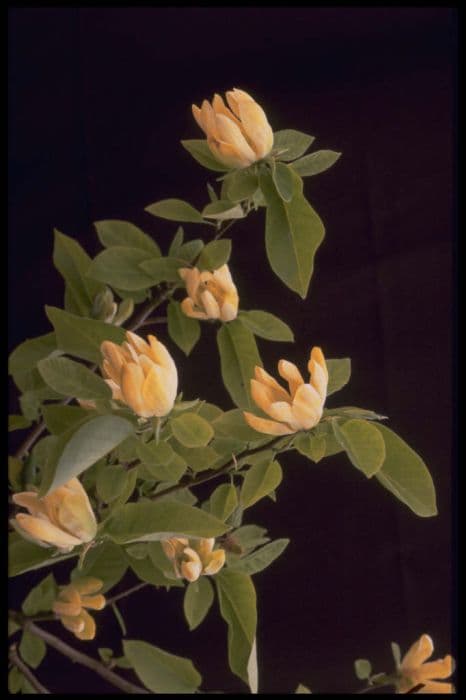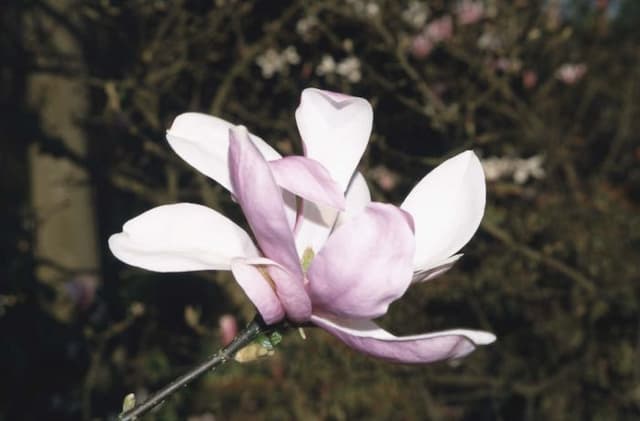Star magnolia Magnolia stellata 'Centennial'

ABOUT
The Magnolia stellata 'Centennial', commonly known as the Star Magnolia, is a striking ornamental plant renowned for its abundant and showy floral display. This cultivar is notable for its star-shaped flowers that burst into bloom in early spring before the foliage emerges. The flowers are large and white, with an impressive number of narrow petals that radiate outward, giving the appearance of a twinkling star. The blossoms are richly fragrant, filling the air with a sweet, fresh scent that heralds the arrival of warmer days. The leaves of the Star Magnolia are a lustrous dark green, contrasting beautifully with the pure white of the flowers. Oval in shape, they create a dense, lush canopy as they unfurl after the flowering period is over. This plant has a refined and compact growth habit, with gracefully spreading branches that present the flowers in a way that makes them easily appreciated. The bark is smooth and gray, providing a subtle backdrop for the dramatic floral display and verdant foliage. Overall, the Star Magnolia 'Centennial' presents a visual feast for the eyes and a sensory delight with its fragrant blooms, making it a cherished addition to any garden that seeks to capture the essence of spring.
About this plant
 Names
NamesFamily
Magnoliaceae
Synonyms
Star Magnolia, Centennial Star Magnolia
Common names
Magnolia kobus var. stellata, Magnolia stellata, Magnolia tomentosa, Talauma hodgsonii.
 Toxicity
ToxicityTo humans
The Star Magnolia is generally considered non-toxic to humans. There is no significant research or reports suggesting that this plant is poisonous or would cause any symptoms of poisoning upon ingestion. However, as with many ornamental plants, it is not intended for human consumption and could potentially cause mild stomach upset if ingested in large amounts due to the presence of plant compounds that humans are not accustomed to digesting.
To pets
Similar to its effects on humans, the Star Magnolia is not known to be toxic to pets. There are no widespread reports of serious illness or symptoms associated with the ingestion of this plant by pets. However, it is always a good practice to monitor pets and prevent them from ingesting large quantities of any non-food plants, as individual animals may have unique sensitivities or allergic reactions, potentially resulting in mild gastrointestinal upset.
 Characteristics
CharacteristicsLife cycle
Perennials
Foliage type
Deciduous
Color of leaves
Green
Flower color
White
Height
15-20 feet (4.5-6 meters)
Spread
10-15 feet (3-4.5 meters)
Plant type
Shrub
Hardiness zones
4-8
Native area
Japan
Benefits
 General Benefits
General Benefits- Ornamental Value: The star magnolia is prized for its beautiful, star-shaped, white or pinkish flowers that bloom in early spring.
- Garden Size: With its compact size, it is suitable for small gardens and can also be used in large containers.
- Scent: The blooms emit a light, pleasant fragrance that can add a sensory dimension to garden spaces.
- Four-Season Interest: Aside from spring blooms, it offers autumn color, attractive winter form, and fuzzy buds in late winter.
- Sunlight Adaptation: Star magnolia is adaptable to a range of sunlight conditions from full sun to partial shade.
- Pollinators: The flowers attract pollinators, such as bees, benefiting the local ecosystem.
- Low Maintenance: This magnolia requires minimal pruning and is relatively low maintenance compared to other ornamentals.
- Cold Tolerant: It is quite cold-hardy, making it suitable for a variety of climates.
- Soil Adaptability: The plant adapts to a wide range of soil types, though it prefers moist, well-drained, acidic soil.
- Slow Growth: Its slow growth rate means it rarely outgrows its space and requires less pruning.
 Medical Properties
Medical PropertiesThis plant is not used for medical purposes.
 Air-purifying Qualities
Air-purifying QualitiesThis plant is not specifically known for air purifying qualities.
 Other Uses
Other Uses- Magnolia stellata 'Centennial' branches can be used in floral arrangements, providing a striking and elegant touch to bouquets and centerpieces due to its attractive flowers and buds.
- The wood of this magnolia can be used in fine woodworking for creating small decorative objects, as it is hard and can have a pleasing grain.
- During the blooming season, the petals of the flowers can be scattered in baths for a fragrant and relaxing experience.
- The bark of the magnolia might be incorporated into artistic crafts and natural jewelry, taking advantage of its texture and color.
- Mature leaves can serve as a natural mulch for garden beds, providing nutrients to the soil as they decompose.
- The seed pods, once dried, can be used in decorative displays or as part of educational tools for botanical studies.
- The tree's canopy provides a dense shading area that can be used to protect understory plants that require filtered light.
- Fallen magnolia petals can be used as a natural dye source for fabrics, yielding subtle colors depending on the mordant used.
- As a bonsai, magnolia can be cultivated and shaped over time for the practice of the bonsai art, requiring careful pruning and maintenance.
- The distinct magnolia fragrance can be captured in homemade potpourris, blending the dried petals with other aromatic herbs and spices.
Interesting Facts
 Feng Shui
Feng ShuiThe Star Magnolia is not used in Feng Shui practice.
 Zodiac Sign Compitability
Zodiac Sign CompitabilityThe Star Magnolia is not used in astrology practice.
 Plant Symbolism
Plant Symbolism- Perseverance and Endurance: The Magnolia stellata 'Centennial', commonly known as the 'Star Magnolia', blooms early in spring, often before all the frost has gone. This symbolizes the ability to endure hard conditions and persist despite challenges.
- Nobility and Dignity: Magnolias are often associated with nobility due to their impressive and stately appearance. The 'Star Magnolia' with its elegant star-shaped flowers is seen as a symbol of poise and pride.
- Femininity and Purity: Magnolias have a delicate and pure appearance, with their white flowers being symbolic of femininity and purity. This magnolia variety, with its pure white blossoms, embodies these qualities
- Beauty and Splendor: With its stunning floral display, the 'Star Magnolia' represents beauty, magnificence, and awe-inspiring splendor.
- Longevity and Eternity: Magnolias are known to be long-lived trees. The 'Star Magnolia', as a part of this family, becomes a symbol of longevity and the eternal aspect of life due to its perennial nature.
 Water
WaterThe Star Magnolia requires thorough watering to keep the soil consistently moist but not waterlogged. During the growing season in spring and summer, it should be watered once a week with approximately 1 to 1.5 gallons of water for a young plant; mature trees may need more depending on size and weather conditions. In hotter, drier periods, frequency should increase to twice a week, but it's important to let the soil dry out slightly between waterings. In the fall and winter, reduce the watering frequency as the plant goes dormant and requires less water.
 Light
LightStar Magnolias thrive best in full sun to partial shade. They should be planted in a spot that receives at least 4 to 6 hours of direct sunlight daily, but they can also benefit from some light afternoon shade in hotter climates to protect the blooms from fading.
 Temperature
TemperatureStar Magnolias are hardy in a range of temperatures and can tolerate a minimum of about 20 to -10 degrees Fahrenheit in winter. They grow optimally at average garden temperatures, but it's best to ensure they are not exposed to sudden freezes during their flowering period in spring. Ideal growing temperatures for these magnolias range from 65 to 75 degrees Fahrenheit during the growing season.
 Pruning
PruningPruning is generally done to shape the Star Magnolia or remove any dead or damaged wood, which helps maintain the tree's health and appearance. The best time to prune is soon after the tree finishes blooming in late spring to early summer. Prune sparingly as excessive cutting can reduce flowering; once a year is typically sufficient.
 Cleaning
CleaningNot needed
 Soil
SoilStar Magnolia requires well-draining, acidic to neutral soil with a pH of 5.5 to 7.0. A mixture of loamy soil with peat moss and compost is ideal to retain moisture while providing adequate drainage and nutrients.
 Repotting
RepottingStar Magnolias are slow growers and typically do not need to be repotted often. Repotting every 3 to 5 years or when the root system outgrows the container is sufficient.
 Humidity & Misting
Humidity & MistingStar Magnolia thrives in average outdoor humidity levels; they do not require special humidity conditions. Protection from strong winds can help maintain adequate humidity around the plant.
 Suitable locations
Suitable locationsIndoor
Ensure bright light, cool temperatures, and no drafts for healthy growth indoors.
Outdoor
Plant in partial shade to full sun and shelter from harsh conditions outdoors.
Hardiness zone
4-8 USDA
 Life cycle
Life cycleThe Star Magnolia ('Centennial') begins its life cycle as a seed, which, after a period of stratification to overcome dormancy, germinates in spring. The seedling stage follows, characterized by initial root growth and the emergence of the first leaves. As it enters the vegetative stage, the plant focuses on leaf and stem growth, developing its characteristic bushy habit. Once mature, it enters the flowering stage, typically in early spring, producing fragrant, star-shaped white flowers. After pollination, typically by insects, the flowers develop into aggregate fruit with red seeds, which are dispersed to begin a new life cycle. In the final stage, the plant experiences senescence, where growth slows and, ultimately, the plant dies, although individual Star Magnolias can live for many decades with proper care.
 Propogation
PropogationPropogation time
Early Spring
The most popular method to propagate Magnolia stellata 'Centennial', commonly known as the Star Magnolia, is through hardwood cuttings. This process involves taking a cutting of about 6 to 8 inches (15 to 20 centimeters) in length from a healthy, mature plant during the dormant season, which is typically late fall or early winter. The cutting should have several nodes and be taken from the current or previous year's growth. The bottom cut should be made just below a node, and the top cut should be made just above a node to maximize potential rooting areas. The cutting is then dipped in rooting hormone to encourage root development and planted in a well-draining soil mix. It should be kept at a consistent moisture level and in a protected environment until roots have formed and the plant can be transitioned to its permanent location.









